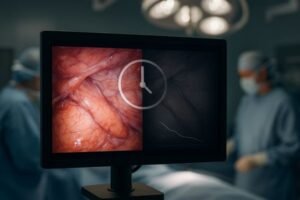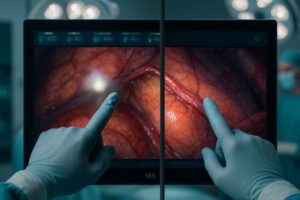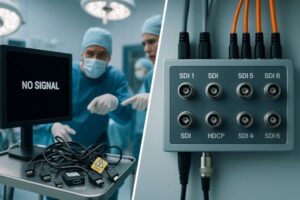Radiologists face the immense challenge of detecting the faintest, most subtle signs of breast cancer, such as tiny microcalcifications or nascent masses, within complex mammographic images. Using standard displays or monitors with insufficient brightness can easily obscure these critical indicators, potentially leading to missed diagnoses and delayed treatment, which can have profound consequences for patient outcomes. High-brightness, high-resolution monitors specifically designed for mammography are essential to illuminate these vital details and empower radiologists in their life-saving work.
because they significantly enhance the visibility of subtle microcalcifications and faint masses by providing superior contrast and detail. The high resolution ensures that the full information from digital mammograms, including intricate tomosynthesis slices, is accurately rendered, supporting compliance with DICOM GSDF standards for optimal diagnostic confidence and early cancer detection.

where we specialize in medical display technology, I’ve dedicated my career to advancing tools that aid medical professionals. I’ve seen how crucial the right display quality is in the fight against breast cancer. Let’s explore why these specialized monitors are indispensable.
How does brightness impact the visibility of microcalcifications?
Microcalcifications, often key early indicators of breast cancer, are incredibly tiny and can appear very faint. On dim or standard screens, these crucial signals can easily blend into the surrounding breast tissue.
High brightness dramatically enhances the conspicuity of subtle microcalcifications by increasing the contrast between these tiny calcium deposits and the surrounding breast tissue, making them significantly easier to spot and assess.

One of my core insights, gained from years working with imaging systems, is that "in mammography, subtle differences in tissue density—especially microcalcifications or early-stage masses—can be easily missed on dim displays. High-brightness monitors make these details stand out sharply." The ability of the human eye to distinguish between different shades of gray, known as Just Noticeable Differences (JNDs)1, is enhanced at higher luminance levels. A brighter screen expands the effective dynamic range, making fainter objects appear more distinct against their background. Our Reshin mammography monitors, such as the MD50C (5MP Color), MD52G (5MP Grayscale), the versatile 8MP Diagnostic Display, and the premium MD120C (12MP), are all engineered with high maximum luminance capabilities2, often exceeding 1000 cd/m², specifically for this reason. This ensures that even the most subtle calcifications3, which might be only a few pixels in size, are rendered with enough contrast to be perceptible to the radiologist, directly contributing to earlier and more accurate detection.
| Feature | Impact on Microcalcification Visibility | Relevant Reshin Models |
|---|---|---|
| High Max Luminance | Increases contrast, makes faint details "pop" | MD50C, MD52G, 8MP, MD120C |
| DICOM GSDF Calibration | Ensures perceptually linear grayscale for accurate density display | All Reshin Diagnostic Monitors |
| Brightness Stability | Consistent image quality over time, preventing gradual decline | All Reshin Diagnostic Monitors |
Why is 5MP or 8MP resolution essential for full-field mammography?
Full-field digital mammography (FFDM) detectors capture an immense amount of data to represent breast tissue accurately. Using a lower-resolution display means that this critical information could be downsampled or averaged out.
A 5MP or 8MP resolution is essential because it ensures that nearly every pixel from the high-resolution FFDM detector is displayed natively, providing the critical clarity needed to scrutinize dense breast tissue and minute architectural details.

My experience confirms that "a 5MP or 8MP monitor4 ensures that every pixel of the high-resolution mammogram is rendered with maximum clarity, especially when examining dense breast tissue." FFDM detectors typically have pixel matrices that demand high-resolution displays5 for optimal viewing. For instance, a 5-megapixel (approx. 2K x 2.5K pixels) monitor like our MD50C or MD52G can display the output of many common detectors at or near a 1:1 pixel mapping. For larger detector sizes or for viewing multiple images side-by-side, an 8MP monitor, like our 8MP Diagnostic Display, or even our MD120C 12MP High-Precision Diagnostic Monitor, becomes invaluable. This high resolution is critical for visualizing the fine spiculations of a mass, subtle architectural distortions, or the characteristics of calcification clusters. In dense breast tissue6, where cancerous signs can be obscured, the ability to see every detail without loss from downscaling is paramount for an accurate diagnosis. Our R&D team, with its extensive experience, ensures Reshin monitors meet these exacting resolution requirements.
What role does luminance play in DICOM-compliant breast imaging?
DICOM Part 14 compliance is a cornerstone of medical imaging, ensuring consistent grayscale representation. However, this calibration can be undermined if the monitor’s luminance capabilities are insufficient for the task.
Luminance is crucial for effective DICOM compliance as it ensures the monitor can accurately and perceptually display the full range of grayscale values defined by the Grayscale Standard Display Function (GSDF).

I firmly believe that "DICOM Part 14 compliance7 is only meaningful when paired with sufficient luminance—otherwise, the calibrated grayscale is visually compromised, undermining diagnostic confidence." The DICOM GSDF standard8 is designed to ensure that changes in pixel values correspond to perceptually linear changes in brightness for the radiologist. However, if a monitor’s maximum luminance (Lmax)9 is too low, the subtle grayscale differences at the brighter end of the scale can become compressed and indistinguishable. High-brightness monitors, like Reshin’s diagnostic displays, possess the necessary luminance range to faithfully reproduce the entire DICOM curve. This means that subtle variations in tissue density, represented by small differences in pixel values, are translated into genuinely perceivable differences in brightness on the screen. All Reshin diagnostic monitors feature precise DICOM calibration, and our intelligent backlight sensors help maintain this calibration and luminance stability over time, ensuring consistent diagnostic quality. This combination of high luminance and accurate calibration is what truly delivers diagnostic confidence.
How does monitor brightness affect early cancer detection rates?
The ultimate goal of mammography screening is the early detection of breast cancer when it’s most treatable. If the display technology itself becomes a limiting factor, the chances for early intervention diminish.
Higher monitor brightness directly improves the visibility of faint, low-contrast lesions and subtle microcalcifications – key indicators of early-stage cancer – thereby potentially increasing detection rates and improving patient prognoses.

As I’ve noted, "in mammography, subtle differences in tissue density…can be easily missed on dim displays." Conversely, high-brightness monitors make these details stand out. This isn’t just about aesthetics; it’s about diagnostic efficacy10. When subtle signs of cancer are made more conspicuous, radiologists are less likely to miss them, especially during long reading sessions where fatigue can set in. Furthermore, "brightness stability over time11 is critical—if a monitor dims, radiologists may gradually lose contrast sensitivity without noticing, potentially delaying diagnosis." Reshin’s commitment, backed by over 100 technology patents, is to provide reliable, high-quality display solutions that maintain their performance. By ensuring that even the faintest indicators are clearly visible, high-brightness monitors12 reduce the perceptual burden on radiologists, allowing them to focus on interpretation. While direct causal links in broad studies can be complex, the fundamental principle is clear: better visibility of suspicious findings logically leads to a higher likelihood of their detection at an earlier stage.
Why are high-brightness monitors crucial for tomosynthesis interpretation?
Digital Breast Tomosynthesis (DBT), or 3D mammography, generates a series of thin image slices through the breast. Reviewing this large dataset requires exceptional display clarity and consistency across all layers.
High-brightness monitors are crucial for tomosynthesis as they maintain essential clarity, contrast, and grayscale fidelity across numerous image slices, enabling radiologists to effectively track subtle 3D structural changes and calcifications.

My insight is that "for digital breast tomosynthesis (DBT)13, layer-by-layer reading demands both high luminance14 and high grayscale fidelity to track subtle structural changes in 3D." DBT involves scrolling through dozens, sometimes hundreds, of thin image slices. Each slice must be clearly visualized to detect subtle lesions that might be obscured by overlapping tissue in 2D mammography. High brightness ensures that each slice is displayed with optimal contrast and detail, even when viewed in rapid succession (cine mode). This is critical for tasks like following the path of a distorted duct or confirming that microcalcifications are indeed within a suspicious lesion and not just superimposed from another layer. Reshin’s higher-resolution models like the [8MP Diagnostic Display](https://reshinmonitors.com/md85ca-8mp-mammography-monitor/)15 and the **MD120C 12MP High-Precision Diagnostic Monitor with AI Calibration** are particularly well-suited for DBT, offering both the brightness and pixel density to handle these complex datasets effectively. The consistent, high-luminance performance ensures that radiologists can confidently navigate through the breast volume, spotting abnormalities with greater precision.
Conclusion
In summary, high-brightness 5MP or 8MP mammography monitors, like those from Reshin, are not merely preferable—they are a fundamental necessity, providing the critical visual foundation for radiologists to detect breast cancer accurately and early.
Contact Reshin today at martin@reshinmonitors.com to learn how our diagnostic monitors can support your clinical excellence.
-
Understanding JNDs is crucial for improving image quality in medical imaging. Explore this link to deepen your knowledge. ↩
-
High luminance capabilities enhance image clarity, vital for accurate diagnoses. Discover more about their significance here. ↩
-
Subtle calcifications can indicate serious conditions. Learn more about their impact on mammography and detection accuracy. ↩
-
Explore how high-resolution monitors enhance mammogram clarity, crucial for accurate diagnoses, especially in dense breast tissue. ↩
-
Learn about the significance of high-resolution displays in medical imaging and their impact on diagnostic accuracy. ↩
-
Understand the challenges posed by dense breast tissue in mammography and how technology aids in accurate detection. ↩
-
Understanding DICOM Part 14 compliance is crucial for ensuring accurate medical imaging and diagnostic confidence. Explore this link to learn more. ↩
-
The DICOM GSDF standard is essential for ensuring that brightness changes are perceived accurately, enhancing diagnostic quality. Learn more here. ↩
-
Discover how maximum luminance impacts the clarity and detail in medical images, which is vital for accurate diagnoses. ↩
-
Discover the relationship between display technology and diagnostic efficacy, essential for improving patient outcomes in radiology. ↩
-
Learn about the significance of brightness stability in maintaining contrast sensitivity for accurate diagnoses in radiology. ↩
-
Explore how high-brightness monitors enhance diagnostic accuracy and visibility in medical imaging, crucial for early cancer detection. ↩
-
Explore the advantages of DBT in mammography, including improved detection of subtle lesions and enhanced imaging techniques. ↩
-
Understanding the significance of high luminance can enhance your knowledge of imaging quality and its impact on diagnosis. ↩
-
Discover the advanced features of the 8MP Diagnostic Display that make it ideal for precise mammography imaging. ↩



